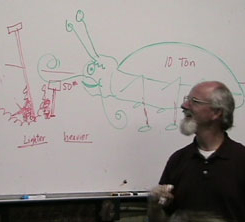How We Teach Science
Our Unique Science and Storytelling Methodology
“I developed my first lesson combining science and storytelling for my daughter’s second grade class, back in 1986. Since then, I’ve refined this method with thousands of students. Most of the science teachers I’ve talked to will start off with a scientific concept, find some sort of a demo or an experiment that relates to it, and give that to the students.
But when I’m creating a new lesson, I start out by experimenting with all sorts of activities that children enjoy doing. Then I try to find the science behind it and create a story that illustrates the science. So our method is pretty much backwards. And it seems to work really well because the kids enjoy what they’re doing and they learn science while they’re doing it. And most of the time, they aren’t really even aware that they’re learning a bunch of science.”
–John McChesney Director, Rock-it Science
Seven Secrets of Rock-it Science:
1. Learning with the Whole Mind. Children learn best when they engage their whole mind — the visual, creative right brain, as well as the linear, analytical left brain. Rock-it Science lessons are carefully designed to appeal to children’s natural creativity and imagination and to provide a whole-mind foundation that supports their regular science lessons.
2. A Stress-Free Environment. We provide a stress-free environment, with no note-taking, memorizing, homework, or tests. We make science fun, so children will become confident and excited about learning science.
3. The Power of Storytelling. Each Rock-it Science lesson introduces a scientific concept through a zany humorous fairytale involving Jack, Jill, and The Evil Mr. Fred. Kids are encouraged to think creatively and suggest possible endings for the story. There are no wrong answers, so each child’s contribution is valued, boosting their self-esteem. See also Morality in Rock-it Science Stories.
4. Hands-On Experimentation. Each child gets to personally manipulate objects and materials and watch how they bounce, light up, dissolve, fly, break, disappear or do other strange and wonderful things. It’s not just a whole-mind experience — it’s a whole-body experience!
5. Observation without Expectation. When you don’t tell kids what they’re “supposed” to observe, they notice all kinds of things. So we don’t tell them what the result is supposed to be — we just give them some materials and general instructions and let them try things out and observe what happens (the first step in the scientific method).
6. The Joy of Discovery. In a Rock-it Science lesson, children get to try things out, make mistakes, make corrections, and discover how to solve problems. They don’t just reproduce something that some scientist has previously discovered — they experience the joy of discovery for themselves!
7. The Magic of Memory. Anything that triggers a child’s memory of the story will also help them remember the scientific principle, and their classroom teacher or home school parent can use this later to reinforce their regular lessons. The children are also more likely to remember what they’ve learned, not because they’ve memorized it, but because they’ve personally discovered and experienced it!
How We Conduct Our Classes
Our science classes are not “age appropriate.” We assume that the students can understand things better than adults.
We don’t teach concepts, vocabulary, and facts. We provide problems to solve, hidden in crazy cliff-hanger stories, and we let the students develop their own concepts, vocabularies, and facts. (Read more)



Follow Us